Experienced medium tanks T-44-100
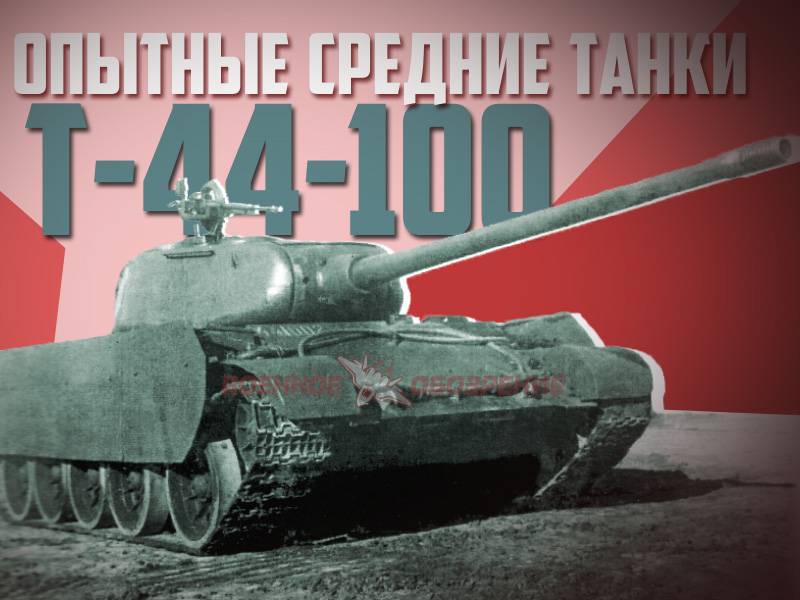
In 1943-44, Soviet industry made an attempt to strengthen the firepower of the latest tank T-44 with a 122 mm rifled gun. Experimental tank T-44-122 showed a significant increase in firing characteristics while at the same time an unacceptable decrease in combat effectiveness. They refused to further develop the medium tank with a powerful gun, but the idea of equipping the armored vehicle with a new gun was continued. Next search result new weapons for the medium tank became the project T-44-100.
The reasons for the emergence of new projects were simple and clear. In 1943, the Red Army tanks had to face the newest German heavy tanks, which had a significant advantage in effective fire range. It was soon found that existing 122-mm guns used on heavy tanks were capable of striking enemy vehicles at different ranges. The result was a proposal to equip the newest medium tank T-44 with a high-powered weapon. Nevertheless, tests have shown that such a machine, having high firepower, is distinguished by an extremely inconvenient fighting compartment and unacceptably small ammunition.
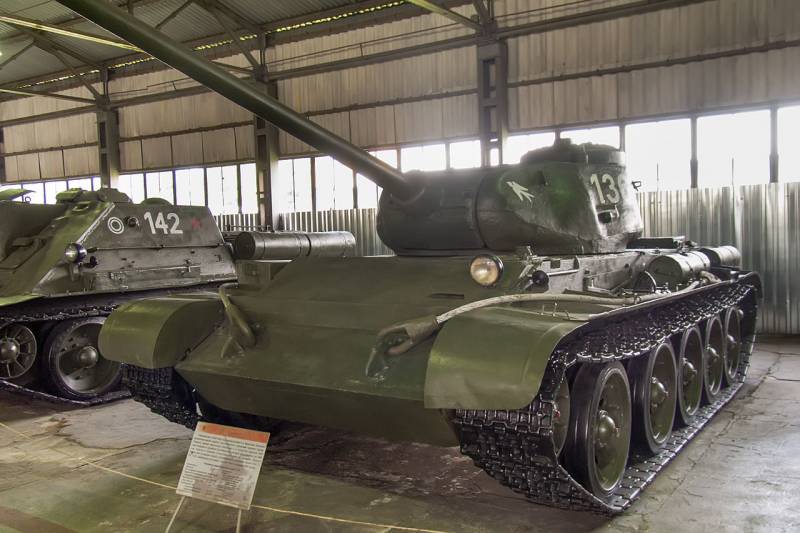
Museum serial T-44. The first sample T-44-100 outwardly almost did not differ from it. Wikimedia Commons Photos
Despite the failure of the project T-44-122, the military and industry have not abandoned the idea of upgrading the medium tank with the replacement of guns. A new attempt at such an update was made already in 1945 year. This time it was proposed to install an existing D-10T cannon of 100 mm caliber on the armored vehicle. Such a tool was used on several existing and promising models of armored vehicles and managed to establish itself as a reliable and effective means of dealing with enemy vehicles. In addition, it compares favorably with the 122-mm guns smaller size.
By analogy with the previous project, a new model of armored vehicles received the working designation T-44-100, showing both the type of base armored vehicle and the caliber of the new weapon.
The previous experimental project involved the removal of a standard gun with fastening systems and the subsequent installation of new equipment along with a more powerful tool. To install the 100-mm guns, the serial medium tank had to undergo similar changes, but along with them it was proposed to use some new improvements. Over time, there was a proposal to use additional booking elements, so that an experienced T-44-100 tank could differ from the base vehicle not only with increased firepower, but also enhanced protection. At the same time, however, no major modifications were made to the existing structure.
At the heart of the project T-44-100 lay the design of the serial tank T-44 with all its characteristic features. It was proposed to use a ready-made armored body, welded from sheets of different thickness and shape. Protection of the front hemisphere of the tank was placed on inclined front sheets with a thickness of 90 mm. The boards had a thickness of 70 mm, feed - up to 45 mm. The case was protected from above and below by a roof up to 20 mm thick and 15-mm bottom. A characteristic feature of the T-44 hull, which distinguished it from the aggregates of previous domestic medium tanks, was the use of a frontal sheet without large openings and openings. Used traditional layout of the hull with the front compartment control, fighting compartment in the center and the engine-transmission in the stern.
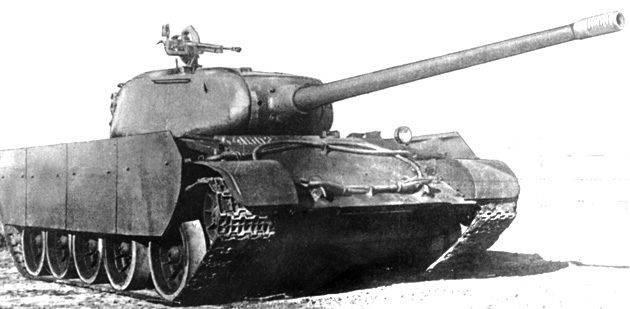
The second version of the T-44-100, equipped with screens and tools LB-1. Photo Armor.kiev.ua
In the engine compartment of the updated tank, they retained the BNXX B-44 diesel engine with the HP 500 power. A five-speed gearbox and other transmission assemblies previously used on the base model tank were used. The existing undercarriage design was retained. On each side there were five large-diameter road wheels with an individual torsion bar suspension. The drive wheels were located in the stern, guides - in front of the hull.
Project T-44-100 again proposed the preservation of the existing casting tower with a frontal part up to 120 mm thick. The side portions of the tower had a thickness of up to 90 mm, feed - 75 mm. The tower was mounted on a pursuit with a diameter of 1800 mm, which made it possible to mount various weapons in it, including quite large ones. A similar modernization potential of the tower has already been confirmed in a previous project.
In the frontal embrasure of the turret, an updated swing installation with an X-NUMX-mm D-100T rifled gun should now be placed. Initially, this gun was developed for the T-10 tank, but now it was proposed to use it in the modernization project of an older armored vehicle. A similar approach to updating the T-54 in theory allowed us to obtain a unification of the two samples that could simplify the operation and supply of ammunition to the units.

Scheme of booking a tank with screens. Figure Bronetehnika.narod.ru
100-mm tank gun had a rifled barrel length 53,5 caliber, consisting of a pipe-monoblock, coupling and breech. A horizontal wedge gate equipped with semi-automatic mechanisms was used. Retractable parts of the gun weighed 1538 kg, swinging part - 2257 kg. The gun was charged manually and used unitary shots. Depending on the type of projectile, a long barrel could provide an initial velocity from 600 to 900 m / s. Manual loading allowed to do up to 5-6 shots per minute.
The gun could use 100-mm unitary shots with projectiles of several types. To hit armored targets, it was originally proposed to use the projectile BR-412. With an initial speed of 880 km / s, this projectile could penetrate 135 mm of armor at a distance of 1 km (meeting angle 90 °) or 100 mm at 2 km. In the future, the Soviet industry created new ammunition for the D-10T cannon, which was distinguished by higher characteristics. However, for obvious reasons, they could not get into the ammunition of the medium tank T-44-100.
The use of a new weapon required the redevelopment of the ammunition assembly accordingly. The larger shot size caliber 100 mm led to a reduction in ammunition to 36 shells. Work with the shells had a separate member of the crew.
The new tank was supposed to get a proven composition of additional weapons. On one machine with a gun, a twin DTM machine gun was placed, the second was placed in the embrasure of the front hull sheet. The use of an anti-aircraft machine gun, according to some sources, was not originally proposed. Later on, a turret appeared on the roof of the tower for mounting a large-bore DShK. Machine gun rifle caliber had a total ammunition 2000 cartridges, anti-aircraft - 200 cartridges.
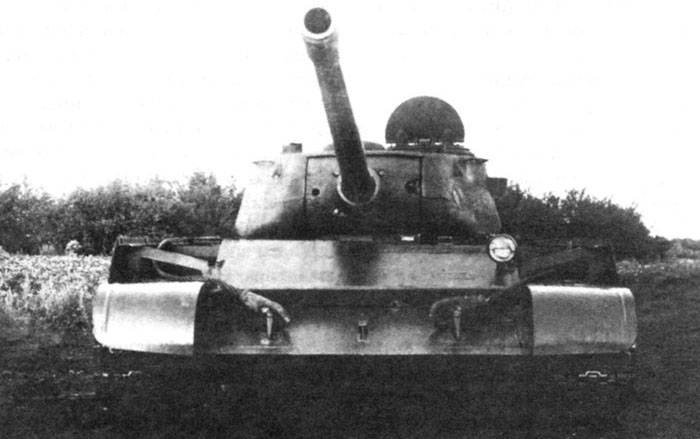
Experienced tank, front view. Photo Scalemodels.ru
To drive the car had four tankers. The driver was placed in the front of the hull and fell into place through the hatch in the roof of the hull. The commander, gunner and loader were placed in the fighting compartment, equipped with two hatches in the roof of the tower. All crew jobs were equipped with viewing devices, sights, etc.
The absence of serious changes in the design of the hull and turret allowed to keep the tank dimensions at the same level. The length of the hull slightly exceeded 6 m, width - 3,2 m, height - 2,41 m. The length of the cannon forward grew noticeably and now exceeded 8-8,2 m. Combat weight from the original 31,8 t increased to 33,5 t. compensate for weight gain and maintain mobility at an acceptable level.
The development of the T-44-100 project was completed in the spring of 1945, after which the assembly of the first prototype started. By the summer of the same year, a prototype reached the test site, which apparently did not have any noticeable differences from the base type machine. It was possible to distinguish the original T-44 and the new T-44-100 only along different lengths of the stems. During the tests, it was found that the upgraded machine shows satisfactory mobility characteristics and, in general, corresponds to the basic technology.
Tests with shooting failed. It was found that the used high-powered weapon cannot be fully used on the T-44 tank. At the site it turned out that the gun was not balanced and interfered with the normal operation of equipment. Powerful recoil 100-mm guns when firing rocked the tank and knocked down a tip. Finally, after a series of shots in the pursuit of the tower, there was a gap. It became clear that in the existing configuration the new tank has no real prospects and cannot be used by the army.
Project T-44-100 sent for revision in order to get rid of the identified deficiencies. It was decided that the D-10T cannon cannot be used on an existing armored vehicle. In addition, there was a proposal for some changes in the composition of weapons, as well as on strengthening the reservation. Similar improvements to the existing project in theory allowed us to obtain the required characteristics, as well as get rid of existing problems.
The 100-mm rifled tank gun LB-1 was proposed as an alternative to the already tested weapon. This gun was developed a little earlier for use on an experimental T-34-100 tank and was a variant of the existing 85-mm LB-1 gun using a new larger-caliber barrel. In general, according to its characteristics, the LB-1 gun corresponded to the D-10T, however, there were some differences in the design. The most notable difference was the use of the muzzle brake. This device was introduced into the design of the gun in order to reduce recoil and reduce its effect on the units of the carrier tank. Given the results of testing the first prototype of the T-44-100, such characteristic features of the LB-1 gun were of interest.
In the basic configuration, the medium tank T-44 was not equipped with undercarriage protection. Over the upper branch of the caterpillar was a fenders shelf, which did not provide any protection. In the side view, there were no additional elements. In the second version of the T-44-100 project, it was proposed to get rid of this design flaw by using additional side screens. Large sheets of armor 8 mm thick were fixed on the side ends of the shelves. Such screens were distinguished by a relatively small height and the presence of bevelled corners. The screen covered the side of the hull, as well as the chassis in the interval from the front road roller to the drive wheel. The presence of additional reservations allowed us to protect the car from cumulative ammunition sent to the board.
According to some information, it was in the second modernization project that the use of a large-caliber DShK anti-aircraft machine gun mounted above the loader's hatch was provided.
In the autumn of 1945, an experienced tank with an LB-1 gun and side screens went to the landfill. Improvements in the design did not again lead to any major changes in mobility. At the same time, the firing characteristics of the updated machine were of greater interest to the customer and the designers. Shooting showed that the less powerful recoil of the new 100-mm gun allowed to get rid of the buildup of the machine. The tower remained in its place and the work of the shoulder strap was not disturbed. Nevertheless, there was a noticeable flaw: the muzzle brake, reducing the recoil force, formed a cloud of dust and unmasked the tank.
According to the results of tests of the second version of the experimental T-44-100 tank, conclusions were drawn and the real prospects of such equipment were determined. The customer decided that the experimental tank could not be adopted and put into serial production. The reasons for this were associated with the features of the resulting machine, and with the advent of new technology, which had some advantages.
By the time of testing the experimental T-44-100 tank, the industry had time to begin mass production of the latest T-54 type machines. Such tanks were originally equipped with X-NUMX-mm gun D-100T. As a result, the serial T-10 and the experienced T-54-44 were equivalent in terms of armament. At the same time, the D-100T gun did not have a muzzle brake, which was considered a definite advantage - at that time, the military was inclined to perceive such devices negatively. The new serial tank also featured more powerful armor and improved mobility.
With some similarities, the T-54 and T-44-100 tanks differed significantly from each other in certain features. A comparison of the two samples showed that from the point of view of future operation in the army, the new T-54 looks much more profitable. It was decided to build such equipment further, and the T-44-100 project should have been closed due to the lack of real prospects. Works have been terminated. For several months, we built and tested an experimental technique with the D-10T and LB-1 cannons, but such samples did not receive the approval of customers with corresponding consequences for the entire project.
The idea of increasing the firepower of the medium tank T-44 by installing a new gun appeared in the 1943 year, shortly after the start of the development of this machine. Over the next two years, the Soviet industry developed two options for upgrading the tank, involving the use of three 100 caliber guns and 122 mm. All three variants of the experimental equipment showed certain advantages over the tank of the basic version, but at the same time they demonstrated a number of characteristic drawbacks. The fundamental impossibility of eliminating these shortcomings, as well as the emergence of new cars, which initially had high enough characteristics, led to the abandonment of interesting projects. Further development of the armament of the T-44 tanks was not carried out. All the forces of tank building were thrown on the improvement of the T-54 and the creation of newer machines.
On the materials of the sites:
http://aviarmor.net/
http://battlefield.ru/
http://bronetehnika.narod.ru/
http://tankinfo.ru/
http://armor.kiev.ua/
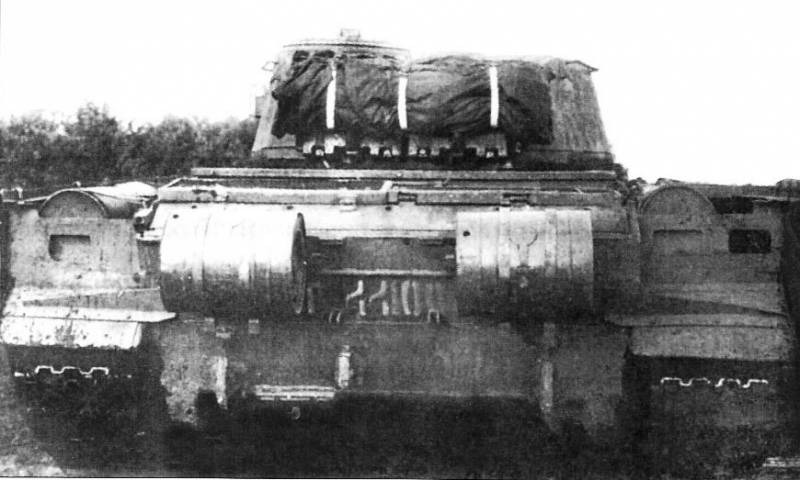
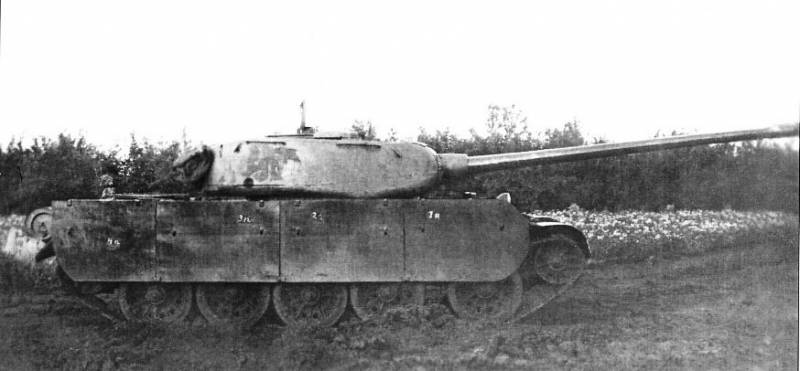
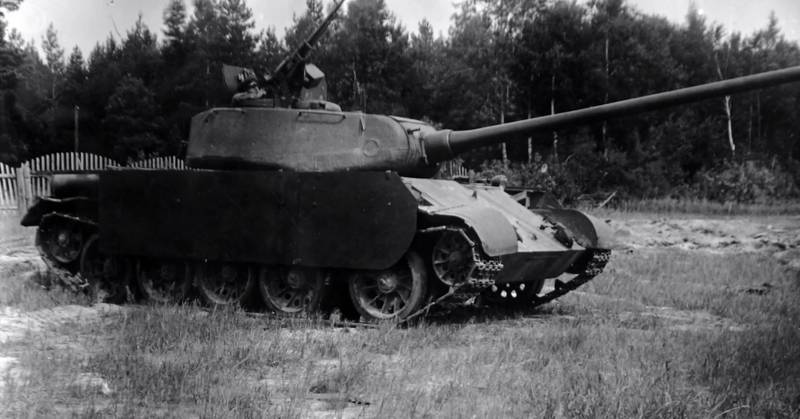
Information